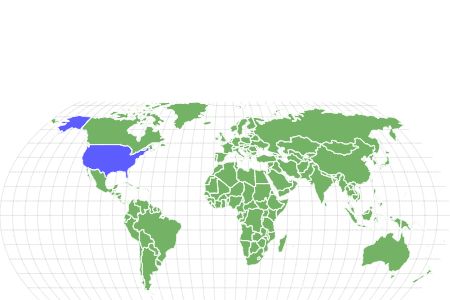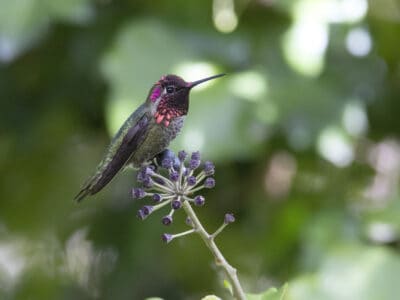Black-Footed Ferret
Mustela nigripes
Black footed ferrets are the only ones native to North America.
Advertisement
Black-Footed Ferret Scientific Classification
- Kingdom
- Animalia
- Phylum
- Chordata
- Class
- Mammalia
- Order
- Carnivora
- Family
- Mustelidae
- Genus
- Mustela
- Scientific Name
- Mustela nigripes
Read our Complete Guide to Classification of Animals.
Black-Footed Ferret Conservation Status
Black-Footed Ferret Facts
- Prey
- Prairie dogs, ground squirrels, birds, insects
- Name Of Young
- Kit
- Group Behavior
- Solitary
- Fun Fact
- Black footed ferrets are the only ones native to North America.
- Estimated Population Size
- 206 mature individuals
- Biggest Threat
- Habitat loss, trapping
- Most Distinctive Feature
- Black mask
- Other Name(s)
- American polecat, Prairie dog hunter
- Gestation Period
- 41-43 days
- Litter Size
- 3-4
- Habitat
- Grasslands, plains
- Predators
- Badgers, coyotes, golden eagles, bobcats, and owls
- Diet
- Carnivore
- Type
- Mammal
- Common Name
- Black Footed Ferret
- Location
- North America
Black-Footed Ferret Physical Characteristics
- Color
- Black
- White
- Cream
- Skin Type
- Hair
- Lifespan
- 48 months
- Weight
- 1.5-2.5 lbs
- Length
- 18-24 inches
- Age of Sexual Maturity
- 1 year
- Age of Weaning
- 4 months
View all of the Black-Footed Ferret images!
“The black-footed ferret is the only ferret native to North America”
The habitat of Black-footed ferrets includes a range extending over the plains of Wyoming, Montana, South Dakota, and Arizona. They are carnivores with a diet consisting mostly of prairie dogs. These mammals have a long, sleek body that allows them to easily fit into tunnels and burrows. They are solitary animals with a lifespan of 3 to 4 years in the wild.
5 Incredible Black-Footed Ferret Facts!
- Big talkers: These vocal animals communicate with one another by chattering, hissing, and whining
- Sleepyheads: They sleep 21 hours each day and are only active at night
- A prairie dog hunter: These ferrets are expert at pursuing their prairie dog prey including following them into their own burrows
- Solitary animals: They live alone most of the year except during the breeding season
- Back from extinction: These ferrets were believed to be extinct until a small group of them were found in 1981
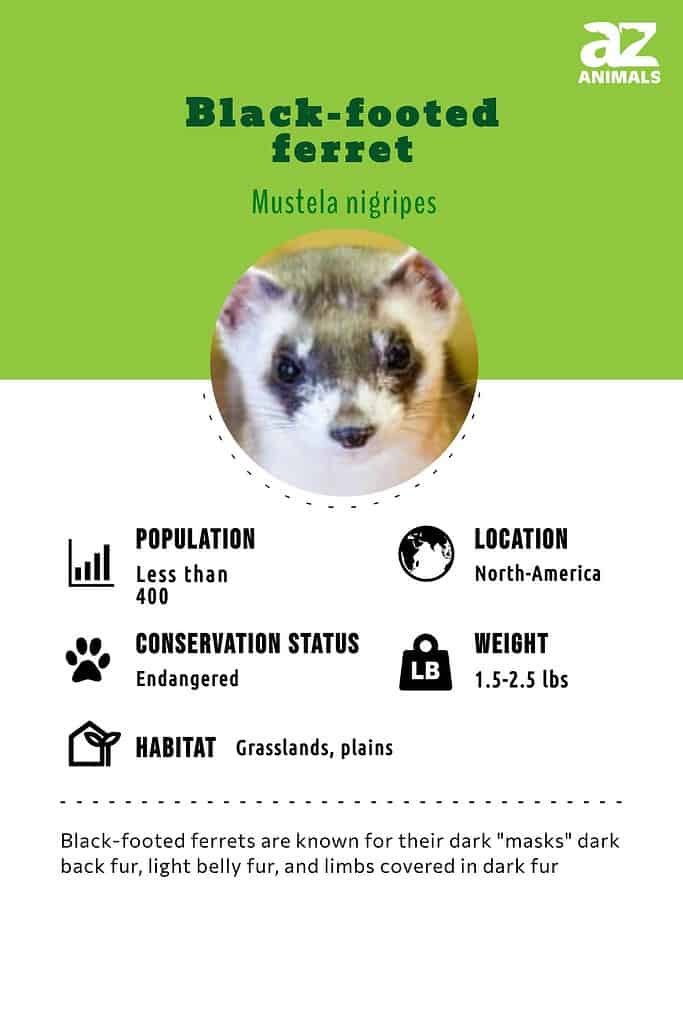
Scientific Name
Mustela nigripes is the scientific name of the black-footed ferret. Mustela is a Latin word meaning weasel while nigripes translates to black-footed. This animal is sometimes called an American polecat.
It belongs to the Mustelidae family and the class Mammalia.
Appearance & Behavior
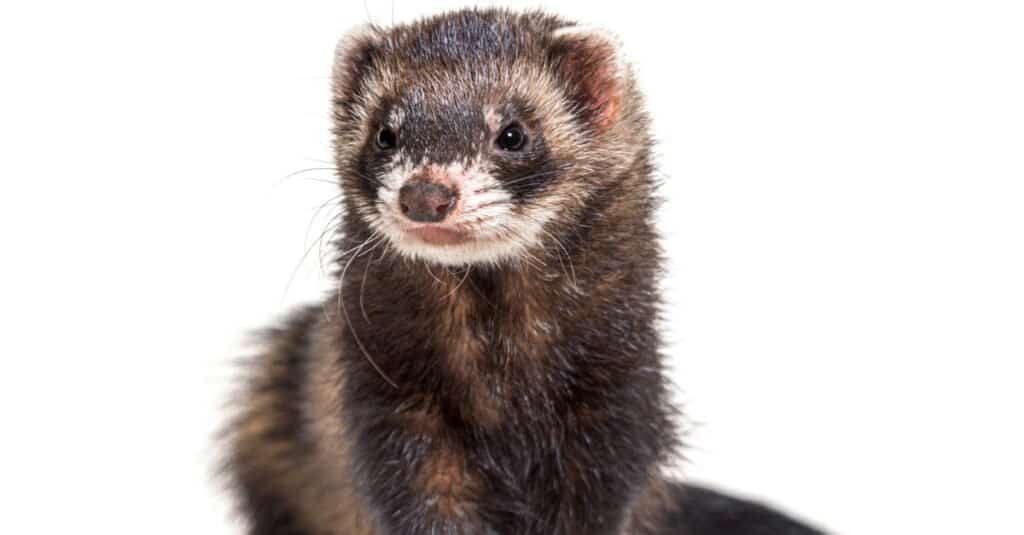
American polecats weigh about 2 lbs with males being bigger than females
©iStock.com/GlobalP
The black-footed ferret has a long, slender body with white to cream-colored fur on its back along with black feet and a black-tipped tail. One of the most notable facts about its appearance is the black fur on its face that makes it look like it’s wearing a mask. This ferret aka American polecat measures 18 to 24 inches in length with a tail 5 to 6 inches long. An adult black-footed ferret weighs an average of 2 pounds. Males are normally bigger than females. As a comparison, a 24-inch-long ferret is equal to 11 golf tees lined up end to end. A 2-pound black-footed ferret is equal in weight to 1 ½ basketball. The heaviest black-footed ferret weighs in at 2.5 pounds.
The black-footed ferret has many adaptations that help it to survive in its habitat. For one, its wiry, slender body allows it to slip into a prairie dog burrow in pursuit of its prey. Its large eyes help this mammal to see in the dark. Another one of its amazing adaptations is a strong sense of smell. This ferret finds prey and navigates its environment by detecting the scents all around it. The cream-colored coat of this ferret helps it to blend into its habitat so it can hide from predators. This animal’s sharp claws are used to dig into the ground to create a new burrow or expand an existing one. A strong jaw helps this ferret to capture and hold a prairie dog. When one ferret spots a predator near its burrow, the animal starts to chatter and hiss to signal danger to other ferrets nearby.
Black-footed ferrets are solitary animals. But, when they do form a group it’s called a business. There are usually 3 or more ferrets in a business. These mammals are shy but may become aggressive during mating season.
Evolution
Black-footed ferrets are part of the large Mustelid family which itself consists of 55 species. Included in that family are mink, otters, and weasels. A common feature most members share is an elongated, slender body, comparatively short legs and a small head with a short snout, and a preference for a carnivorous diet.
Ferrets’ earliest known ancestor Mustela stromeri is believed to have also been the forbear of two mid-Pleistocene subspecies, Mustela eversmanni and M. putorius. Black-footed ferrets are believed to have emerged about 2 million years ago developing a preference for a diet of prairie dogs after evolving simultaneously with them over millennia. They are also believed to have already been living in North America, by the Late Paleolithic, about 100,000 years ago.
Why is the Black-Footed Ferret Endangered?
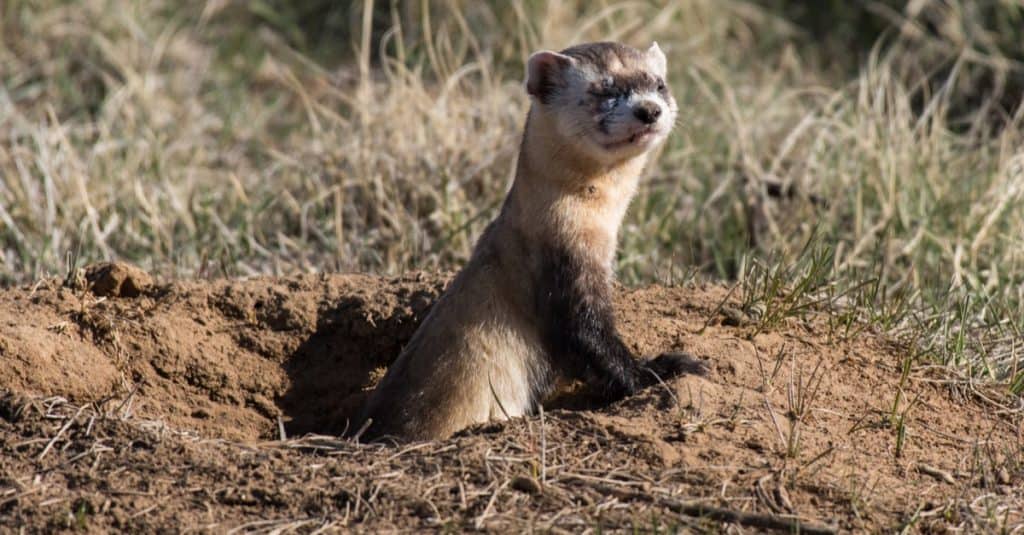
The black-footed ferret once saw its numbers plummet owing to reduced prairie dog numbers
©Kerry Hargrove/Shutterstock.com
Decades ago, the population of the black-footed ferret was so low the species was thought to be extinct. Their numbers were greatly decreased by a plague that ran through the prairie dog population. It is known as the sylvatic plague and is carried by fleas. It kills 90 percent of the prairie dogs that become infected. When the prairie dog population goes down it takes away the main component in the diet of the black-footed ferrets. As a result, these ferrets began to die off in large numbers.
Habitat loss is another reason why the population of the black-footed ferret has fallen so low. Expansion of farmland destroys many of the prairie dog burrows where these ferrets live.
One of the most amazing facts is a small population of black-footed ferrets was discovered in 1981. With the help of captive breeding programs and more community education, this ferret’s population slowly began to increase. However, officially, the black-footed ferret is still Endangered.
Habitat
Black-footed ferrets are native to North America. They live in a range that includes Wyoming, Montana, Arizona, and South Dakota. They live in a temperate location of plains and grasslands. These ferrets don’t migrate. But, they do spend more time in their burrows during the winter season.
Predators and Threats
These animals are carnivores. The diet of this ferret consists mainly of prairie dogs. In fact, this prairie dog hunter eats approximately 100 of these rodents in the course of a year! If one prairie dog weighs 3 pounds, that means a black-footed ferret eats 300 pounds of prairie dogs per year. Imagine, 300 pounds is equal to nine-tenths the weight of a panda bear.
What eats black-footed ferrets?
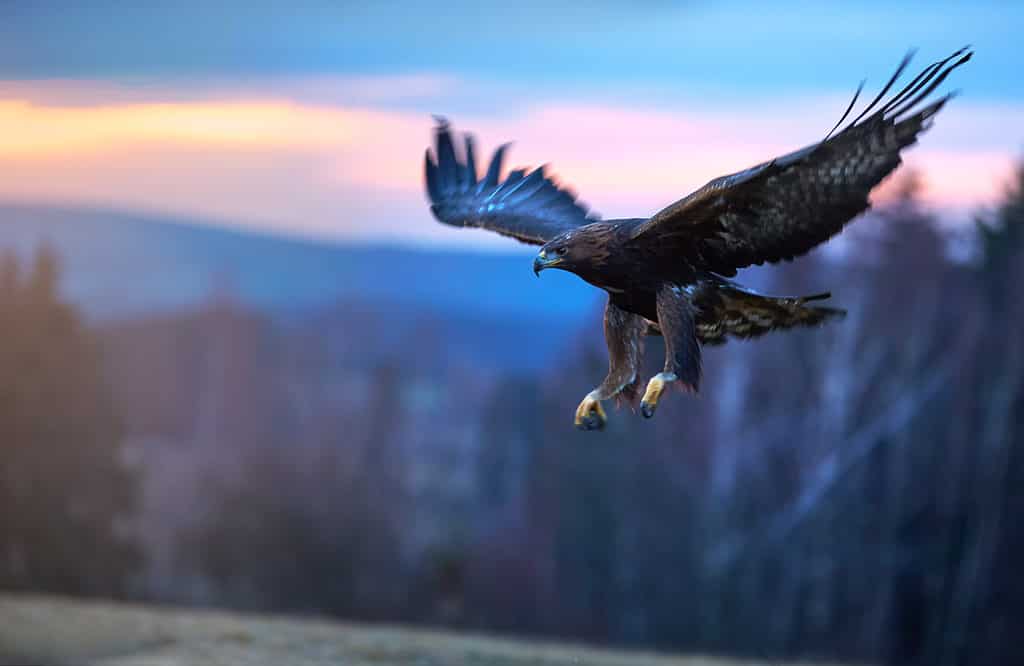
Golden eagles are known to hunt ferrets
©Martin Mecnarowski/Shutterstock.com
Golden eagles, owls, coyotes, bobcats, and badgers are all predators of these animals. Most of these predators are nocturnal as well. An owl flying over the plains can easily see the movements of a black-footed ferret and swoop down to capture one. Or, a bobcat can choose a location near the burrow of a black-footed ferret and wait until it ventures out looking for food at night.
What does a black-footed ferret eat?
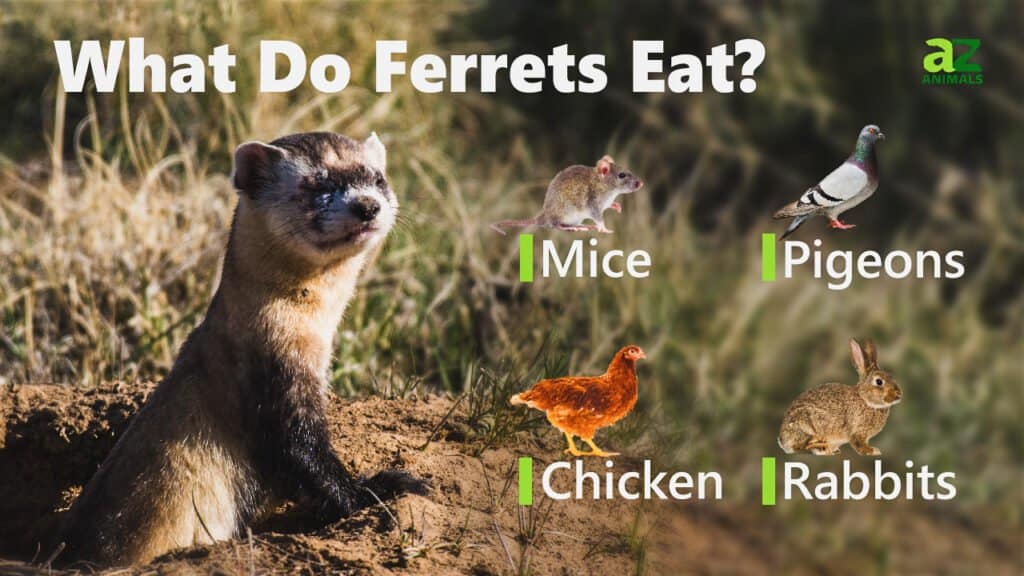
Prairie dogs make up the biggest part of the diet of these animals. This is why this animal is known as an expert prairie dog hunter! They also may eat ground squirrels, mice, rats, rabbits, reptiles, birds, and sometimes insects.
The conservation status of the black-footed ferret is Endangered. When its main diet of prairie dogs decreases, the population of ferrets goes down as well. Also, this ferret is threatened by habitat loss due to land development. They are sometimes killed by farmers who consider them pests that may go after their chickens and smaller livestock.
There are conservation actions being taken now to protect this ferret. These actions include captive breeding and educating the public about these unique animals.
Reproduction and Life Cycle
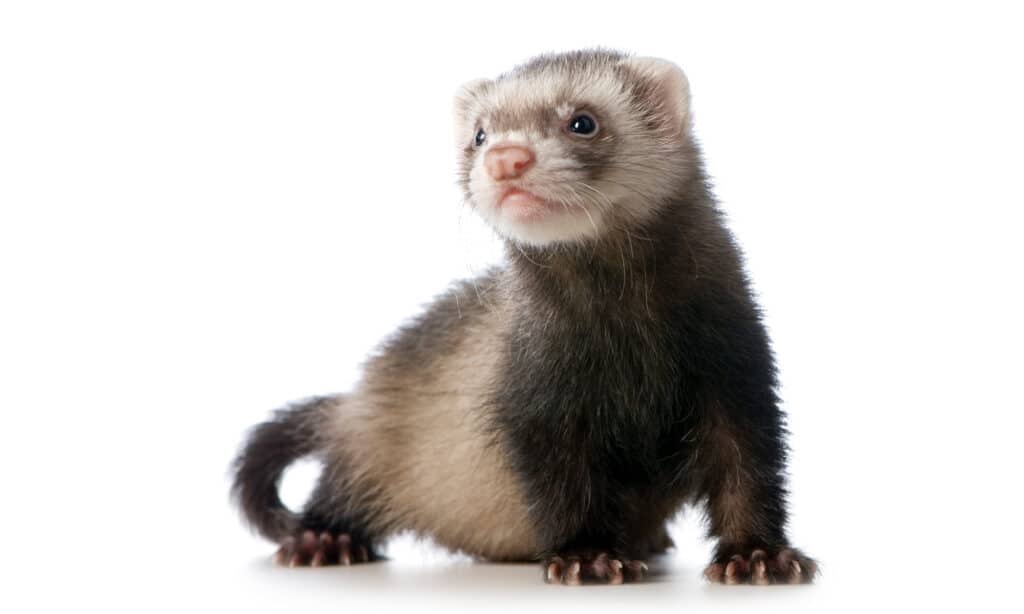
Black-footed ferrets live for a maximum of four years in the wild
©iStock.com/GlobalP
The breeding season of these animals happens in March and April. In this species, female ferrets compete for males. The gestation period of a female is 41 to 43 days. They give live birth to 3 to 4 babies also called kits. The female ferret cares for the kits in the burrow after they are born. The male doesn’t play a part in the care of the young.
Newborn ferrets weigh from 0.2 to 0.3 ounces. They are born with their eyes closed and have a thin coat of white hair. They are mostly helpless until their eyes open. In about 3 weeks, they begin to get black markings on their fur, and their eyes open at 35 days old. After being weaned at around 3 months old, the kits begin to venture out of their underground location as their mother teaches them how to hunt for food. They stay with their mother for about 5 or 6 months before going off to live independently.
The lifespan of these animals is 3 to 4 years. The record for the oldest black-footed ferret is 9 years.
Population
According to the IUCN Red List of Threatened Species, the population of these animals consists of 206 mature individuals. The conservation status of this ferret is endangered, and they have a decreasing population.
View all 285 animals that start with BBlack-Footed Ferret FAQs (Frequently Asked Questions)
Are black-footed ferrets carnivores, herbivores, or omnivores?
Black-footed ferrets are carnivores.
What do black-footed ferrets eat?
This small animal, sometimes called the American polecat, eats prairie dogs. In fact, prairie dogs make up 90% of its diet. These ferrets also eat ground squirrels, rats, mice, rabbits, reptiles, birds, and bugs.
Where do black-footed ferrets live?
These ferrets live in a range that covers Wyoming, Montana, Arizona, and South Dakota. Specifically, their habitat includes grasslands and plains. They use prairie dog burrows as shelter. Their wiry, slender bodies and strong senses of sight, hearing, and smell are adaptations that help them to survive in this challenging environment.
What is killing the black-footed ferret?
When prairie dogs die off due to disease or are poisoned as pests, it results in a decrease in the population of the black-footed ferret. Also, these ferrets are losing their habitat due to the expansion of farmland and other types of land development.
This animal has a relatively short lifespan of 3 to 4 years, so it takes a long time to fortify its population.
Why are black-footed ferrets going extinct?
Loss of their main food source and their habitat have contributed to the decrease in the black-footed ferret population. However, there are conservation steps now being taken. Captive breeding and educating the public on these animals have helped to slowly raise their population.
Can black-footed ferrets be pets?
Technically, black-footed ferrets can be kept as pets. But pet ferrets available from breeders or pet stores are usually descended from European ferrets and not the American polecat.
How many black-footed ferrets are left?
According to the IUCN, there are 206 mature individuals left. But, with consistent conservation efforts and more education, this number may slowly increase.
Thank you for reading! Have some feedback for us? Contact the AZ Animals editorial team.
Sources
- US Fish & Wildlife Service, Available here: https://www.fws.gov/mountain-prairie/es/blackFootedFerret.php
- Wikipedia, Available here: https://en.wikipedia.org/wiki/Black-footed_ferret
- Montana Field Guide, Available here: http://fieldguide.mt.gov/speciesDetail.aspx?elcode=AMAJF02040

